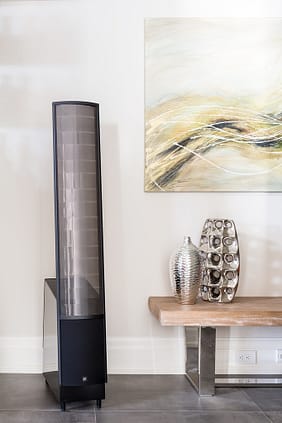Advantages of Traditional Electromagnet vs Electrostatic Speakers
Traditional speakers, the conical variety of varying sizes we’re used to seeing almost everywhere, are a tried and true technology, and the principles of how they work are fairly easy to understand. But what are the advantages of traditional electromagnet speakers vs. electrostatic speakers? We break it down for you.
Electromagnet speakers use a cone of paper or some other flexible material attached to a fixed, stable ring on the speaker’s face. At the back of the narrow end of the cone is a metal coil, behind which is a large magnet. Sound travels as electrical pulses to the coil, which results in it being charged and attracted to the magnet behind. The pulses and the movement of the coil move the cone, displacing air and producing sound waves.
Large cones aren’t able to move as fast as small cones, and the slower cones, therefore, produce lower frequency (bass) sound, while the smaller, faster cones produce what we hear as the mid and high-frequency components of sound. Subwoofers are generally large, slow speakers, while tweeters are generally small, fast speakers, with mid-sized, mid-frequency speakers filling in the middle to round out the sound.
Electrostatic speakers, by contrast, don’t use cones, coils, or magnets. Instead, they leverage a large diaphragm with its surface area coated in a conductive material and sandwiched between two electrically charged grids. One grid is positively charged, while the other is negatively charged. Sound travels as electrical pulses through the conductive diaphragm, charging it positively or negatively and causing it to be attracted to one of the charged panels and repelled by the other. The resulting push/pull of the diaphragm displaces air producing sound waves.
As the diaphragm itself in modern designs is made of an ultralight material, the electrostatic speaker can move much more quickly than a traditional electromagnetic speaker, resulting in a much higher potential fidelity of sound. Overcoming inertia is a significant consideration in the performance of a speaker, and with direction changes upwards of 40,000 times a second, lighter material results in less inertia, which results, in high-end designs, in a more responsive speaker.
Low-frequency sound, the deep bass in music and movie soundtracks, is most effectively delivered by traditional electromagnetic cone speakers, which is why manufacturers of high-end electrostatic speaker systems, like MartinLogan, typically provide hybrid solutions, with a thin electrostatic upper speaker for high-fidelity in the mid to high range, and a traditional electromagnetic cone speaker for warmth and richness in low-mid and low end.
MartinLogan has spent decades innovating and continually improving their speakers to bring “Truth in Sound”, which they define as “much more than a catchphrase, it’s our philosophy: MartinLogan speakers are designed to render the most complex musical passages as faithfully as a prism disperses the color spectrum.”
Ask us about MartinLogan speakers.

MartinLogan: Truth in Sound


